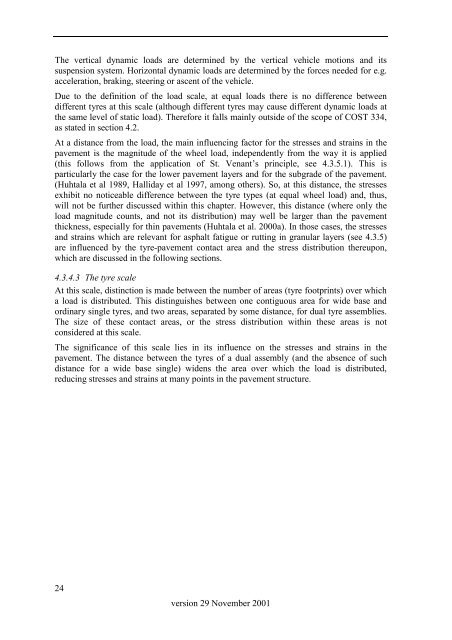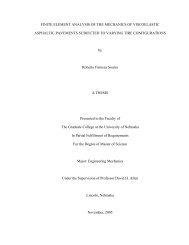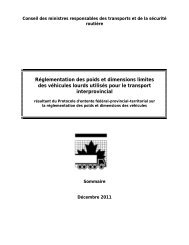The vertical dynamic loads are determined by the vertical vehicle motions and itssuspension system. Horizontal dynamic loads are determined by the forces needed for e.g.acceleration, braking, steering or ascent of the vehicle.Due to the definition of the load scale, at equal loads there is no difference betweendifferent tyres at this scale (although different tyres may cause different dynamic loads atthe same level of static load). Therefore it falls mainly outside of the scope of <strong>COST</strong> <strong>334</strong>,as stated in section 4.2.At a distance from the load, the main influencing factor for the stresses and strains in thepavement is the magnitude of the wheel load, independently from the way it is applied(this follows from the application of St. Venant’s principle, see 4.3.5.1). This isparticularly the case for the lower pavement layers and for the subgrade of the pavement.(Huhtala et al 1989, Halliday et al 1997, among others). So, at this distance, the stressesexhibit no noticeable difference between the tyre types (at equal wheel load) and, thus,will not be further discussed within this chapter. However, this distance (where only theload magnitude counts, and not its distribution) may well be larger than the pavementthickness, especially for thin pavements (Huhtala et al. 2000a). In those cases, the stressesand strains which are relevant for asphalt fatigue or rutting in granular layers (see 4.3.5)are influenced by the tyre-pavement contact area and the stress distribution thereupon,which are discussed in the following sections.4.3.4.3 The tyre scaleAt this scale, distinction is made between the number of areas (tyre footprints) over whicha load is distributed. This distinguishes between one contiguous area for wide base andordinary single tyres, and two areas, separated by some distance, for dual tyre assemblies.The size of these contact areas, or the stress distribution within these areas is notconsidered at this scale.The significance of this scale lies in its influence on the stresses and strains in thepavement. The distance between the tyres of a dual assembly (and the absence of suchdistance for a wide base single) widens the area over which the load is distributed,reducing stresses and strains at many points in the pavement structure.24version 29 November 2001
Chapter 44.3.4.4 The contact area scaleAt this level of schematisation, the average vertical stress considered is the ratio of theapplied load to the contact area value. It depends mainly on the tyre inflation pressure, theapplied load and on the tyre design.When a uniform, free rolling, wheel motion is applied on a flat pavement, the longitudinalstress corresponds to the tyre rolling resistance and is very low. It is lower for wide basesingle tyre assemblies, which have a lower rolling resistance level.For vehicle acceleration, turning, climbing, braking, or even a uniform vehicle motion(overcoming air resistance as well as rolling resistance) horizontal forces have to betransferred by some of the vehicle’s tyres, giving rise to larger horizontal stresses. Whensuch a driving or braking torque is applied on the tyre assemblies, its effect has to be takeninto account.When no transversal force is applied, the transversal exerted stress is equal to zero. If atransversal force is applied on the tyre assemblies (e.g. when the vehicle is turning), itsinfluence has to be taken into account.This scale is very important when road wear is considered. Indeed, it is relevant for theintermediate and upper pavement layers in which fatigue and rutting may occur. For thestresses and strains in the pavement (as opposed to the interface stresses), not only the sizeof the contact area is important, but also its shape. There will be differences in stresses inthe pavement between e.g. a wide and short contact area, a square area, a circular area, or anarrow and long area (all having equal area size and vertical contact stress).4.3.4.5 The tread pattern scaleinterface stressesAt this scale, the tyre-pavement interface stresses are considered to be constant across thetread pattern parts or ribs. Many studies have been conducted at this scale. See, forinstance De Beer et al (1996), Neddenriep et al (1996), Groenendijk et al (1997) and Blab(1999). (These researchers all considered stresses at the local scale too, as e.g. thetransverse contact stress varies considerably over the tread rib width.)A general description for a free rolling wheel is given below. In addition, extensive dataand explanations can be found in Clark (1982). Furthermore, Figure 4.9 shows someresults of De Beer et al (1996) for a free rolling (no torque applied, nor lateral force)Bridgestone 425/65R22.5 radial wide single tyre. Wheel load was 50 kN (the ratedmaximum for this tyre) and inflation pressure was 900 kPa. As the recommended pressurewas 830 kPa cold for the rated wheel load, the actual pressure is close to the recommendedpressure in warm conditions. Wheel speed was about 16 km/h.version 29 November 200125






